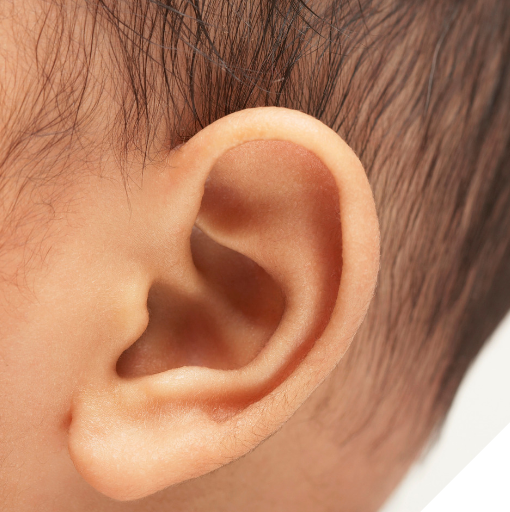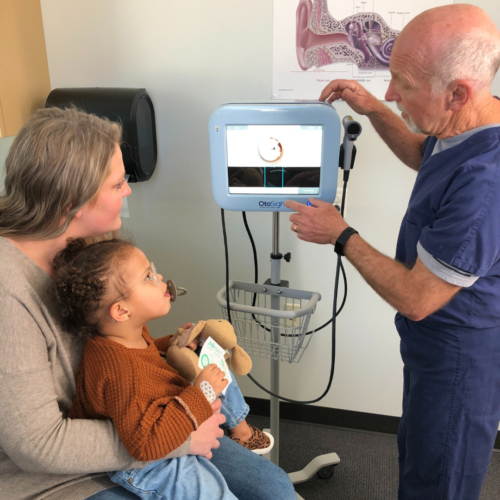Phone
866-411-EARS
Address
PhotoniCare Inc.
2800 Meridian Parkway, Suite 175
Durham, NC 27713

As a parent, you always want to have the answers. You have a tiny human being that has to depend on you for all of his or her needs. You helped create this smiling bundle of joy and you want to put him or her on the best possible track for success; however, some things happen that are outside of your control and expertise. One of those things that commonly affect infants and small children is an ear infection.
Eight out of 10 children will have a middle ear infection, but what if your child seems to have them more than what you think is normal? What if your child seems to have difficulty hearing and complains about “water in the ear” when there doesn’t seem to be a reason for it? When this happens, it may be time to seek help by calling your primary care doctor or ENT specialist for the best next steps for your child’s ear health.
WHAT ARE EAR TUBES?
Ear tubes go by many names – myringotomy tubes, tympanostomy tubes, ventilation tubes – but they’re all the same thing. They are small, hollow tubes made of plastic or metal that are surgically inserted into an incision in your child’s eardrum. This procedure creates an opening that allows air ventilation of the middle ear, drains any fluid present, and stops the buildup of fluid behind the eardrum. By doing this, the risk of ear infections is mitigated and, as long as the tube stays in place without clogging, the child should not experience any further ear infection-related issues. But even knowing what ear tubes accomplish can still leave some unanswered questions, such as; “How do I even know if my child needs them or not?”
WHEN A CHILD MAY NEED EAR TUBES
Ear tubes are most commonly used in children because their eustachian tubes – the natural ventilation structure of the middle ear – are narrower and more horizontal than in a grown adult. When children develop an upper respiratory infection, the resulting mucus can more easily block the eustachian tubes, which causes an accumulation of fluid in the middle ear. When this problem persists for more than three or four months following an ear infection, it may be time for tubes to be placed in your child’s ears.
Other symptoms that may precede the need for ear tubes are the following:
RISKS ASSOCIATED WITH EAR TUBES
Before making the commitment to getting this surgery for your child, do not be afraid to ask about the risks and benefits of the procedure.
While all types of surgeries in which general anesthesia is used carry a risk, the procedure for placing ear tubes in the eardrum is a relatively quick, safe and effective procedure. However, outcomes may vary. Just because a child receives tubes does not mean he or she can never contract an infection again. There is also the potential risk of scarring or weakening of the eardrum or the tubes staying in too long or falling out early; however, the benefits of receiving tubes generally outweigh the risks.
By receiving the ear tube placement procedure, the child’s risk of future ear infections are lowered and hearing can be restored if one of the symptoms prior to the surgery was hearing loss. Also, speech development can continue on as normal and even the child’s sleep, behavior and communication may be improved if previous ear infections affected one or all of those areas. Finally, the ear tubes will allow time for the child to mature and will help his or her eustachian tube to work more efficiently as it becomes wider and longer.
Finally, after surgery has been completed and the tubes are safely inside your child’s ear, the next step is simply to care for your little one. Antibiotic ear drops and/or pain killers may be prescribed, and your healthcare provider will provide any special post-surgery care instructions. If you notice any drainage, ear pain, or fever after the procedure, you should call your child’s healthcare provider. If all things go according to plan, the tubes should fall out on their own after approximately six to nine months.

The COVID-19 pandemic has created numerous challenges for parents. Navigating… Read More

PhotoniCare sits down with Dr. Michael Novak, an Ear, Nose… Read More

This week on the #EnginEarGuys blog we talk about otolaryngology… Read More